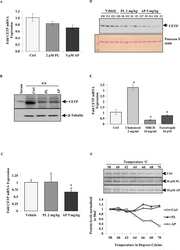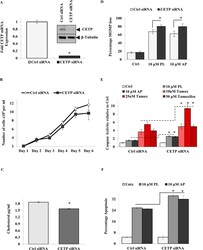Antibody data
- Antibody Data
- Antigen structure
- References [1]
- Comments [0]
- Validations
- Other assay [2]
Submit
Validation data
Reference
Comment
Report error
- Product number
- PA1-050 - Provider product page

- Provider
- Invitrogen Antibodies
- Product name
- CETP Polyclonal Antibody
- Antibody type
- Polyclonal
- Antigen
- Synthetic peptide
- Description
- PA1-050 detects cholesteryl ester transfer protein (CETP) from human tissues. PA1-050 has been successfully used in Western blot procedures. By Western blot, this antibody detects an ~70 kDa band from human liver extracts representing CETP. The PA1-050 immunogen is a synthetic peptide corresponding to residues C D(149) S G R V R T D A P D(159) of human CETP protein.This peptide (Cat. # PEP-209) is available for use in neutralization and control experiments.
- Reactivity
- Human
- Host
- Rabbit
- Isotype
- IgG
- Vial size
- 100 μg
- Concentration
- 1 mg/mL
- Storage
- -20°C, Avoid Freeze/Thaw Cycles
Submitted references Identification of CETP as a molecular target for estrogen positive breast cancer cell death by cholesterol depleting agents.
Esau L, Sagar S, Bangarusamy D, Kaur M
Genes & cancer 2016 Sep;7(9-10):309-322
Genes & cancer 2016 Sep;7(9-10):309-322
No comments: Submit comment
Supportive validation
- Submitted by
- Invitrogen Antibodies (provider)
- Main image

- Experimental details
- NULL
- Submitted by
- Invitrogen Antibodies (provider)
- Main image

- Experimental details
- Figure 4 CETP contributes to cancer cell growth and survival and is upregulated in breast cancer patients (A) CETP gene silencing by siRNA and western blot analysis of CETP protein expression in CETP siRNA cells. (B) Effect of CETP mRNA silencing on growth of MCF-7 cells as measured by cell counting over a period of six days. (C) Comparison of cholesterol levels in the MCF-7 control (ctrl) siRNA and CETP knockout cells. Data shown are the mean +- SD of quadruplicate wells/condition in three independent experiments (n = 3) (P
 Explore
Explore Validate
Validate Learn
Learn Western blot
Western blot Other assay
Other assay